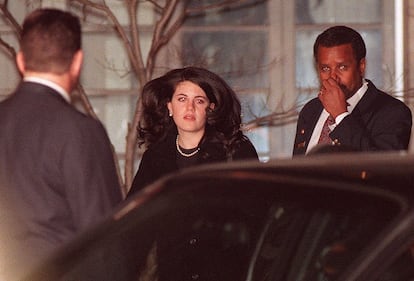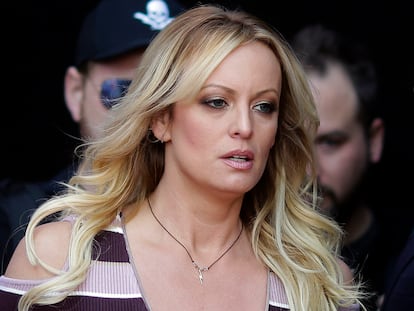Donald Trump, the first former president to be indicted in U.S. history
Before him, half a dozen presidents or vice presidents were enmeshed in impeachment trials or linked to crimes


Donald Trump has been the first to do many things, as a president and as a former president, and some of these things have been far from exemplary. On Thursday, he set a new record by becoming the first former resident of the White House to be indicted, over a case involving the cover-up of a payment of $130,000 to buy the silence of porn actress Stormy Daniels shortly before the 2016 election that would make him president. But he is not the first U.S. head of state to have run afoul of the law throughout history: a handful of presidents or vice-presidents have been immersed in political trials or linked to crimes.
The first U.S. president to be impeached was Andrew Johnson (1865-1869). In his case, not because there were any doubts about his record as a good citizen, but for purely political reasons: his term of office was dominated by a constant confrontation with Congress over his reconstruction initiatives after the Civil War (1861-1865). Johnson, a Democrat from the southern state of Tennessee, had allowed the secessionist states to quickly rejoin the Union. He had pardoned Confederate soldiers, and he vetoed bills that Congress had adopted to protect the rights of slaves who had just regained their freedom. He dismissed his Secretary of War, Edwin Stanton, who objected to his benevolence toward the former Confederate states. The confrontations reached their peak in 1868: the House of Representatives opened impeachment proceedings against him. Although the lower house concluded that he should be dismissed, the Senate acquitted him. But Johnson did not want to run for a second term.
His successor, Ulysses S. Grant (1869-1877), had problems of a different kind: when he rode in his horse-drawn carriage, he liked to go fast. He was stopped once for speeding, but the police let him go after imposing a single fine.
It would be almost a century before reaching what, until now, had been the biggest and most notorious scandal in U.S. politics: Watergate, which cost Richard Nixon his job (1969-1974). The Republican president who claimed that “I am not a crook” resigned in 1974 before the beginning of an impeachment trial. Although a grand jury had named him as one of the participants in the case, charges were never brought against him and his successor in the White House, his former vice-president Gerald Ford, issued a pardon.
The case, which was taken to the big screen as All the President’s Men, starring Robert Redford and Dustin Hoffman, erupted after members of Nixon’s re-election committee raided the Democratic Party headquarters in the offices of the Watergate complex on the Potomac River to install wiretaps and steal documents. The bugs did not work, and five individuals went back to change them. At that point they were discovered.
At first, Nixon tried to cover up his involvement, and he went so far as to dismiss the independent special counsel who was investigating the case. The scandal escalated to the Supreme Court, which ruled that the president had to release the tapes he kept of all his conversations. Those tapes implicated him.
Nixon’s term was also peppered with other political scandals. His vice-president Spiro Agnew had resigned in 1973 after accepting a charge of tax evasion. The charge was part of a broader investigation related to alleged bribes he had received during his time in local politics in the state of Maryland, where he became governor.
But if the case of the Republican president who reestablished diplomatic relations with Mao Zedong’s China marked a before and after in contemporary American politics, that of Bill Clinton (1993-2001), the biggest sex scandal in the history of American politics, was no less of a media circus.
In 1998, the House of Representatives impeached Clinton for lying under oath and obstruction of justice after the president attempted to cover up his affair with White House intern Monica Lewinsky, who was 22 at the time. As had happened 130 years earlier, the process did not succeed and the president was acquitted by the Senate. However, the erosion of the president’s popularity meant that his second term in office was that of a discredited leader, unable to carry out ambitious projects.
Clinton’s problems had begun in the state where he was governor, Arkansas, where there were suspicions about his involvement in the Whitewater real estate scam. A state official, Paula Jones, had sued him for sexual harassment. The Democrat became the first president to testify in his own defense before a jury.
As part of the case, investigators called the former intern to testify about her relationship with the president. On January 26, 1998, Clinton uttered one of the phrases that would mark his presidency: “I did not have sexual relations with that woman, Miss Lewinsky.” The key to the impeachment process was precisely to determine whether the president, who had oral sex with the young woman, had committed perjury by denying the affair and whether he obstructed justice by encouraging the young woman to deny the relationship.
Sign up for our weekly newsletter to get more English-language news coverage from EL PAÍS USA Edition
Tu suscripción se está usando en otro dispositivo
¿Quieres añadir otro usuario a tu suscripción?
Si continúas leyendo en este dispositivo, no se podrá leer en el otro.
FlechaTu suscripción se está usando en otro dispositivo y solo puedes acceder a EL PAÍS desde un dispositivo a la vez.
Si quieres compartir tu cuenta, cambia tu suscripción a la modalidad Premium, así podrás añadir otro usuario. Cada uno accederá con su propia cuenta de email, lo que os permitirá personalizar vuestra experiencia en EL PAÍS.
¿Tienes una suscripción de empresa? Accede aquí para contratar más cuentas.
En el caso de no saber quién está usando tu cuenta, te recomendamos cambiar tu contraseña aquí.
Si decides continuar compartiendo tu cuenta, este mensaje se mostrará en tu dispositivo y en el de la otra persona que está usando tu cuenta de forma indefinida, afectando a tu experiencia de lectura. Puedes consultar aquí los términos y condiciones de la suscripción digital.
More information
Archived In
Últimas noticias
Petro claims the ELN was the target of US attack in Venezuela
Maduro counterattacks Trump with rhetoric and announces downing of nine drug trafficking aircraft
‘Ecce Homo’: The miraculous disaster that made a small Spanish town famous
Return to sex testing at the Olympics: IOC edges closer to banning transgender women
Most viewed
- Sinaloa Cartel war is taking its toll on Los Chapitos
- Oona Chaplin: ‘I told James Cameron that I was living in a treehouse and starting a permaculture project with a friend’
- Reinhard Genzel, Nobel laureate in physics: ‘One-minute videos will never give you the truth’
- Why the price of coffee has skyrocketed: from Brazilian plantations to specialty coffee houses
- Silver prices are going crazy: This is what’s fueling the rally









































